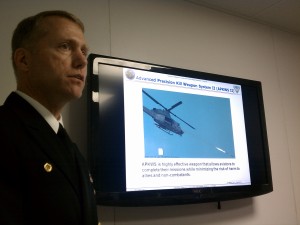Sea-Air-Space: APKWS Goes to War

By Jay Friess
Editor
The Advanced Precision Kill Weapon System, a laser guidance modification for the thousands of 2.75-inch “dumb” rockets in the Navy’s inventory, has been deployed to Afghanistan and saw combat last month, according to Capt. Brian Corey, program manager for PMA-242.
Corey spoke Tuesday at a small press briefing held at the BAE Systems booth at the Sea-Air-Space convention being held by the Navy League in National Harbor, Maryland.
Corey explained that the original 2.75-inch rockets used by the military were developed in World War II and haven’t changed much since. “The one we used today is largely unmodified,” Corey said.
The APKWS is a self-contained guidance system that is inserted between the motor and warhead of existing rockets, similar to how JDAM satellite guidance units are added to existing “dumb” bombs. The unit senses the acceleration of the rocket, turns itself on and deploys four wings, called “flaperons.” Each flaperon is equipped with a laser sensor. Working in conjunction, the flaperons keep the rocket guided to a target painted with a laser shot either by an aircraft or a ground spotting team.

This model of a standard 2.75-inch rocket the Advanced Precision Kill Weapon system was on display at the BAE Systems booth at the Navy League's Sea-Air-Space convention.
“The weapon doesn’t care where it gets the laser source,” Corey said.
The APKWS unit adds 19 inches of length to the 55-inch rockets and another 9 pounds of weight, which caused the team to have to test how well the longer rockets would fit in legacy launchers. There are approximately 100,000 legacy 2.75-inch rockets in the Navy’s arsenal, Corey said.
During initial and operational tests at China Lake, Calif. last year, 100 APKWS-equipped rockets hit the laser mark within one meter every single time when launched from legacy Cobra and Huey helicopters. The system does not require any additional equipment for aircraft already equipped to fire legacy rockets.
An APKWS-equipped rocket has a 4.8 kilometer range with a minimum distance to target of 1,500 meters, according to Corey.
“We’ve been very satisfied with our result in testing,” Corey said, noting that the program requirements only called for 94 percent accuracy.
The program completed initial operational test and evaluation in January, received the Pentagon testing office’s blessing in February and went operational in March. The units have been produced in two initial low-rate production runs of 325 and 600. Corey said the decision of whether to put the unit into full production will be made later this year.
So far, under low-rate production, the APKWS units have cost $28,000 apiece. They are being mounted to rockets that cost between $1,500 and $2,000 apiece.
Now that the unit has been certified for Marine helicopters, the program will be turning toward engineering it for jet aircraft. The unit is being developed to withstand colder temperatures and more vibration, Corey said. The program plans to begin testing a fixed wing version of the unit in spring of 2013.
























